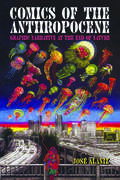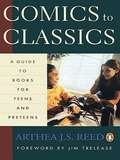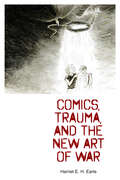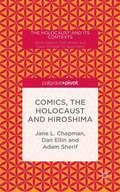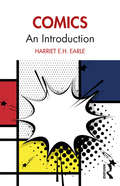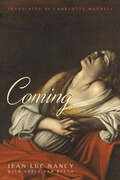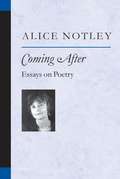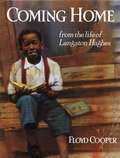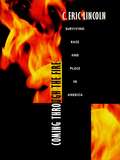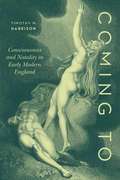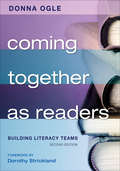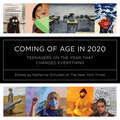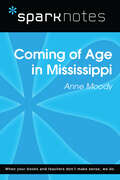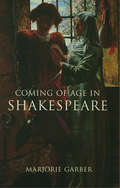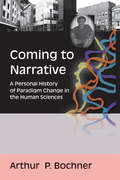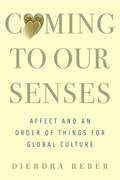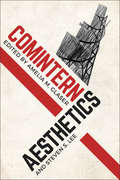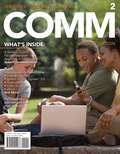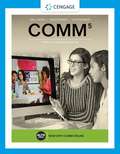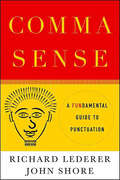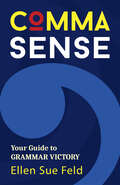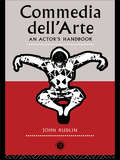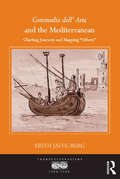- Table View
- List View
Comics of the Anthropocene: Graphic Narrative at the End of Nature
by José AlanizSince the first Earth Day in 1970, how have US comics artists depicted the human-caused destruction of the natural world? How do these representations manifest in different genres of comics like superheroes, biography, underground comix, and journalism? What resources unique to the comics medium do they bring to their tasks? How do these works resonate with the ethical and environmental issues raised by global conversations about the anthropogenic sixth mass extinction and climate change? How have comics mourned the loss of nature over the last five decades? Are comics “ecological objects,” in philosopher Timothy Morton’s parlance? Weaving together insights from comics studies, environmental humanities, critical animal studies, and affect studies to answer these questions, Comics of the Anthropocene: Graphic Narrative at the End of Nature explores the representation of animals, pollution, mass extinctions, and climate change in the Anthropocene Era, our current geological age of human-induced environmental transformation around the globe. Artists and works examined in Comics of the Anthropocene include R. Crumb, Don McGregor et al.’s Black Panther, Jack Kirby’s Kamandi: The Last Boy on Earth, the comics of the Pacific Northwest, and Stephen Murphy and Michael Zulli’s landmark alternative series The Puma Blues. This book breaks new ground in confronting our most daunting modern crisis through a discussion of how graphic narrative has uniquely addressed the ecology issue.
Comics to Classics: A Guide to Books for Teens and Preteens
by Jim Trelease Arthea J. ReedFor each developmental stage between the ages of 10 and 18, educator Arthea Reed provides lists of books all carefully selected and organized for teen appeal. This guide will help parents and older children choose the right books for every reading level and interest.
Comics, Trauma, and the New Art of War
by Harriet E. EarleConflict and trauma remain among the most prevalent themes in film and literature. Comics has never avoided such narratives, and comics artists are writing them in ways that are both different from and complementary to literature and film. In Comics, Trauma, and the New Art of War, Harriet E. H. Earle brings together two distinct areas of research--trauma studies and comics studies--to provide a new interpretation of a long-standing theme. Focusing on representations of conflict in American comics after the Vietnam War, Earle claims that the comics form is uniquely able to show traumatic experience by representing events as viscerally as possible.Using texts from across the form and placing mainstream superhero comics alongside alternative and art comics, Earle suggests that comics are the ideal artistic representation of trauma. Because comics bridge the gap between the visual and the written, they represent such complicated narratives as loss and trauma in unique ways, particularly through the manipulation of time and experience. Comics can fold time and confront traumatic events, be they personal or shared, through a myriad of both literary and visual devices. As a result, comics can represent trauma in ways that are unavailable to other narrative and artistic forms.With themes such as dreams and mourning, Earle concentrates on trauma in American comics after the Vietnam War. Examples include Alissa Torres's American Widow, Doug Murray's The 'Nam, and Art Spiegelman's much-lauded Maus. These works pair with ideas from a wide range of thinkers, including Sigmund Freud, Mikhail Bakhtin, and Fredric Jameson, as well as contemporary trauma theory and clinical psychology. Through these examples and others, Comics, Trauma, and the New Art of War proves that comics open up new avenues to explore personal and public trauma in extraordinary, necessary ways.
Comics, the Holocaust and Hiroshima
by Jane L. Chapman Dan Ellin Adam SherifComics and the Holocaust breaks new ground for cultural history by exploring the relationship between comics as a cultural record, historiography, memory and trauma studies. Comics have a dual role as sources: for gauging awareness of the Holocaust and through close analysis, as testimonies and narratives of childhood emotions and experiences.
Comics: An Introduction
by Harriet E.H. EarleComics: An Introduction provides a clear and detailed introduction to the Comics form – including graphic narratives and a range of other genres – explaining key terms, history, theories, and major themes. The book uses a variety of examples to show the rich history as well as the current cultural relevance and significance of Comics. Taking a broadly global approach, Harriet Earle discusses the history and development of the form internationally, as well as how to navigate comics as a new way of reading. Earle also pushes beyond the book to lay out the ways that fans engage with their comics of choice – and how this can impact the industry. She also analyses how Comics can work for social change and political comment. Discussing journalism and life writing, she examines how the coming together of word and image gives us new ways to discuss our world and ourselves. A glossary and further reading section help those new to Comics solidify their understanding and further their exploration of this dynamic and growing field.
Coming
by Jean-Luc NancyComing is a lyrical, erudite examination of the French notion of jouissance. How did jouissance evolve from referring to the pleasure of possessing a material thing (property, wealth) to the pleasure of orgasm, from appropriation to dis-appropriation, from consumption to consummation? The philosophers Adèle van Reeth and Jean-Luc Nancy engage in a lively dialogue, ranging from consumerism to video games to mysticism and from Spinoza, Hegel, andAugustine to the Marquis de Sade, Marguerite Duras, and Henry Miller. Four additional essays are new to the American edition.
Coming After: Essays on Poetry
by Alice NotleyComing After gathers critical pieces by acclaimed poet Alice Notley, author of Mysteries of Small Houses and Disobedience. Notley explores the work of second-generation New York School poets and their allies: Ted Berrigan, Anne Waldman, Joanne Kyger, Ron Padgett, Lorenzo Thomas, and others. These essays and reviews are among the first to deal with a generation of poets notorious for their refusal to criticize and theorize, assuming the stance that "only the poems matter." The essays are characterized by Notley's strong, compelling voice, which transfixes the reader even in the midst of professional detail. Coming After revives the possibility of the readable book of criticism.
Coming Home: From The Life Of Langston Hughes
by Floyd CooperYoung Langston Hughes was a dreamer. He dreamed about heroes like Booker T. Washington, who was black just like him. When he heard the clackety-clack of train wheels, he dreamed about the places it had been. <P><P>But most of all, he dreamed about having a happy home. And so, one day, he began turning those dreams into beautiful prose. As he did, he discovered where his home really was—in the words and rhythms of his poetry that reached people all over the world. <p><p>The beloved Langston Hughes comes to life in a book for poets, dreamers, children and adults; anyone who has ever thought of what home means to them.
Coming Through the Fire: Surviving Race and Place in America
by C. Eric LincolnIn Coming through the Fire, prominent scholar and writer C. Eric Lincoln addresses the most important issue of our time with insights forged by a lifetime of confronting racial oppression in America. Born in a small rural town in northern Alabama, raised by his grandparents, Lincoln portrays in rich detail the nuances of racial conflict and control that characterized the community of Athens, personal experiences which would lead him to dedicate his life to illuminating issues of race and social identity. The contradictions and calamities of being black and poor in the United States become a purifying fire for his searing analyses of the contemporary meanings of race and color. Coming through the Fire, with its fiercely intelligent, passionate, and clear-eyed view of race and class conflict, makes a major contribution to understanding-and thereby healing-the terrible rift that has opened up in the heart of America. Lincoln explores the nature of biracial relationships, the issue of transracial adoption, violence-particularly black-on-black violence-the "endangered" black male, racism as power, the relationship between Blacks and Jews, our multicultural melting pot, and Minister Louis Farrakhan. Without sidestepping painful issues, or sacrificing a righteous anger, the author argues for "no-fault reconciliation," for mutual recognition of the human endowment we share regardless of race, preparing us as a nation for the true multiculture tomorrow will demand. Readers familiar with Lincoln's earlier groundbreaking work on the Black Muslims and on the black church will be eagerly awaiting the publication of Coming through the Fire. Others will simply find C. Eric Lincoln's personal story and his exploration of survival and race in America to be absorbing and compelling reading.
Coming To Terms: A Theory of Writing Assessment
by Patricia LynneIn a provocative book-length essay, Patricia Lynne argues that most programmatic assessment of student writing in U.S. public and higher education is conceived in the terms of mid-20th century positivism. Since composition as a field had found its most compatible home in constructivism, she asks, why do compositionists import a conceptual frame for assessment that is incompatible with composition theory? By casting this as a clash of paradigms, Lynne is able to highlight the ways in which each theory can and cannot influence the shape of assessment within composition. She laments, as do many in composition, that the objectively oriented paradigm of educational assessment theory subjugates and discounts the very social constructionist principles that empower composition pedagogy. Further, Lynne criticizes recent practice for accommodating the big business of educational testing—especially for capitulating to the discourse of positivism embedded in terms like "validity" and "reliability." These terms and concepts, she argues, have little theoretical significance within composition studies, and their technical and philosophical import are downplayed by composition assessment scholars. There is a need, Lynne says, for terms of assessment that are native to composition. To open this needed discussion within the field, she analyzes cutting-edge assessment efforts, including the work of Broad and Haswell, and she advances a set of alternate terms for evaluating assessment practices, a set of terms grounded in constructivism and composition. Coming to Terms is ambitious and principled, and it takes a controversial stand on important issues. This strong new volume in assessment theory will be of serious interest to assessment specialists and their students, to composition theorists, and to those now mounting assessments in their own programs.
Coming To: Consciousness and Natality in Early Modern England
by Timothy M. HarrisonIn Coming To, Timothy M. Harrison uncovers the forgotten role of poetry in the history of the idea of consciousness. Drawing our attention to a sea change in the English seventeenth century, when, over the course of a half century, “conscience” made a sudden shift to “consciousness,” he traces a line that leads from the philosophy of René Descartes to the poetry of John Milton, from the prenatal memories of theologian Thomas Traherne to the unresolved perspective on natality, consciousness, and ethics in the philosophy of John Locke. Each of these figures responded to the first-person perspective by turning to the origins of how human thought began. Taken together, as Harrison shows, this unlikely group of thinkers sheds new light on the emergence of the concept of consciousness and the significance of human natality to central questions in the fields of literature, philosophy, and the history of science.
Coming Together as Readers: Building Literacy Teams
by Donna M. OgleThis second edition helps educators build a successful reading culture by developing community collaborations that include parents, university partnerships, and libraries.
Coming of Age in 2020: Teenagers On The Year That Changed Everything
by Katherine SchultenA time capsule of art and artifacts, created by Gen Z. Everyone knows what coming of age in America is supposed to look like. Then came 2020. Instead of proms and championship games and all-night hangouts with friends, there was school on Zoom from bed. In this book, teenagers from across the country show how they coped with a world on fire, as a pandemic raged, political divides hardened, and the Black Lives Matter movement galvanized millions. Via diary entries, comics, photos, poems, paintings, charts, lists, Lego sculptures, songs, recipes, and rants, they tell the story of the year that will define their generation. The pieces in this collection, chosen from more than 5,500 submitted to a contest on the New York Times Learning Network, provide an arresting documentation of how ordinary teenagers experienced extraordinary events. But for every creative expression of terror, frustration, loneliness, and anxiety, there is another of meaning, joy, resilience, and hope.
Coming of Age in Mississippi (SparkNotes Literature Guide Series)
by SparkNotesComing of Age in Mississippi (SparkNotes Literature Guide) by Anne Moody Making the reading experience fun! Created by Harvard students for students everywhere, SparkNotes is a new breed of study guide: smarter, better, faster.Geared to what today's students need to know, SparkNotes provides:chapter-by-chapter analysis explanations of key themes, motifs, and symbols a review quiz and essay topics Lively and accessible, these guides are perfect for late-night studying and writing papers.
Coming of Age in Shakespeare
by Marjorie GarberMarjorie Garber examines the rites of passage and maturation patterns--"coming of age"--in Shakespeare's plays. Citing examples from virtually the entire Shakespeare canon, she pays particular attention to the way his characters grow and change at points of personal crisis. Among the crises Garber discusses are: separation from parent or sibling in preparation for sexual love and the choice of husband or wife; the use of names and nicknames as a sign of individual exploits or status; virginity, sexual initiation and the acceptance of sexual maturity, childbearing and parenthood; and, finally, attitudes toward death and dying.
Coming to Narrative: A Personal History of Paradigm Change in the Human Sciences (Writing Lives: Ethnographic Narratives #14)
by Arthur P BochnerReflecting on a 50 year university career, Distinguished Professor Arthur Bochner, former President of the National Communication Association, discloses a lived history, both academic and personal, that has paralleled many of the paradigm shifts in the human sciences inspired by the turn toward narrative. He shows how the human sciences—especially in his own areas of interpersonal, family, and communication theory—have evolved from sciences directed toward prediction and control to interpretive ones focused on the search for meaning through qualitative, narrative, and ethnographic modes of inquiry. He outlines the theoretical contributions of such luminaries as Bateson, Laing, Goffman, Henry, Gergen, and Richardson in this transformation. Using diverse forms of narration, Bochner seamlessly layers theory and story, interweaving his professional and personal life with the social and historical contexts in which they developed.
Coming to Our Senses
by Dierdra ReberComing to Our Senses positions affect, or feeling, as our new cultural compass, ordering the parameters and possibilities of what can be known. From Facebook "likes" to Coca-Cola "loves," from "emotional intelligence" in business to "emotional contagion" in social media, affect has become the primary catalyst of global culture, displacing reason as the dominant force guiding global culture. Through examples of feeling in the books, film, music, advertising, cultural criticism, and political discourse of the United States and Latin America, Reber shows how affect encourages the public to "reason" on the strength of sentiment alone. Well-being, represented by happiness and health, and ill-being, embodied by unhappiness and disease, form the two poles of our social judgment, whether in affirmation or critique. We must then re-envision contemporary politics as operating at the level of the feeling body, so we can better understand the physiological and epistemological conditions affirming our cultural status quo and contestatory strategies for emancipation.
Coming to Our Senses: Affect and an Order of Things for Global Culture
by Dierdra ReberComing to Our Senses positions affect, or feeling, as our new cultural compass, ordering the parameters and possibilities of what can be known. From Facebook "likes" to Coca-Cola "loves," from "emotional intelligence" in business to "emotional contagion" in social media, affect has displaced reason as the primary catalyst of global culture.Through examples of feeling in the books, film, music, advertising, cultural criticism, and political discourse of the United States and Latin America, Reber shows how affect encourages the public to "reason" on the strength of sentiment alone. Well-being, represented by happiness and health, and ill-being, embodied by unhappiness and disease, form the two poles of our social judgment, whether in affirmation or critique. We must then reenvision contemporary politics as operating at the level of the feeling body, so we can better understand the physiological and epistemological conditions affirming our cultural status quo and contestatory strategies for emancipation.
Comintern Aesthetics
by Amelia M. Glaser Steven S. LeeFounded by Vladimir Lenin in 1919 to instigate a world revolution, the Comintern advanced not just the proletarian struggle but also a wide variety of radical causes, including those against imperialism and racism in settings as varied as Ireland, India, the United States, and China. Notoriously, and from the organization’s outset, these causes grew ever more subservient to Soviet state interest and Stalinist centralization. Comintern Aesthetics shows how the cultural and political networks emerging from the Comintern have continued, even after its demise in 1943. Tracking these networks through a multiplicity of artistic forms geared towards advancing a common, liberated humanity, this volume captures the failure of a Soviet-centered world revolution, but also its enduring allure in the present. The sixteen chapters in this edited volume examine cultural and revolutionary circuits that once connected Moscow to China, Southeast Asia, India, the Near East, Eastern Europe, Germany, Spain, and the Americas. The Soviet Union of the interwar years provided a template for the convergence of party politics and cultural history, but the volume traces how this template was adapted and reworked around the world. By emphasizing the shared, Soviet routes of these far-flung circuits, Comintern Aesthetics recaptures a long-lost moment in which cultures could not only transform perception, but also highlight alternatives to capitalism, namely, an anti-colonial world imaginary foregrounding race, class, and gender equality.
Comm 2
by Rudolph F. Verderber Kathleen S. Verderber Deanna D. SellnowCreated through a "student-tested, faculty-approved" review process, COMM2 is an engaging and accessible solution to accommodate the diverse lifestyles of today's learners.
Comm 5
by Rudolph F. Verderber Kathleen S. Verderber Deanna D. SellnowLearn Communication YOUR Way with COMM5! This easy-reference, paperback textbook presents course content through visually engaging chapters and Chapter Review Cards that consolidate the best review material into a ready-made study tool. With the textbook or on its own, COMM5 Online allows easy exploration of COMM5 anywhere, anytime--including on your device. Collect your notes, browse interactive content and create StudyBits as you go, to remember what's important. Then, either use preset study resources or personalize the product through easy-to-use tags and filters to prioritize your study time. Make and review flashcards, review related content and track your progress with Concept Tracker--all in one place and at an affordable price!
Comma Sense: A Fun-damental Guide to Punctuation
by Richard Lederer John Shore“A clear, entertaining, and just plain helpful guide to the American rules of punctuation.” —Lynne Truss, #1 New York Times–bestselling author of Eats, Shoots & LeavesAre you confounded by commas, addled by apostrophes, or queasy about quotation marks? Do you believe a bracket is just a support for a wall shelf, a dash is something you make for the bathroom, and a colon and semicolon are large and small intestines? If so, language humorists Richard Lederer and John Shore (with the sprightly aid of illustrator Jim McLean), have written the perfect book to help make your written words perfectly precise and punctuationally profound.With buoyant wit and erudition, Comma Sense reveals the power and importance of each mark of punctuation. Lederer and Shore demonstrate what each has in common with a great American icon: the underrated yet powerful period with Seabiscuit; the jazzy semicolon with Duke Ellington; even the rebel apostrophe with famed outlaw Jesse James. When you’ve finished Comma Sense, you’ll not only have mastered everything you need to know about punctuation, you’ll have had fun doing so.
Comma Sense: Your Guide to Grammar Victory
by Ellen Sue FeldGuide for Grammar, Voice, and Sentence Structure“If you're going to have one grammar book on your shelf, make it this one!” —Dani Alcorn, COO at Writing Academy and cofounder of Writer's Secret Sauce#1 New Release in Writing, Research & Publishing Guides, Composition and Language, Grammar Reference, Semantics, Vocabulary Books, Study & Teaching Reference, Reading Skills, and editingComma Sense by Ellen Feld is a style guide for all things grammar. Learn the rules of adverbs, punctuation, abbreviations, prepositions, and much more. Feld shows you how to write technically, professionally, and personally.Grammar for everyone. Master English grammar with Ellen Feld. Comma Sense goes above and beyond the average grammar book. Professional writers, students, novices, and experts can benefit from learning or relearning the basics of grammar and beyond: em dashes, parentheticals and parallelism, diction and logic, run-on sentences and sentence fragments, and more. Become a master of capitalization and punctuation, subjects and predicates, and contractions and possessives.Test Your Knowledge. After every chapter, take a quiz to practice your new grammatical skills in this great grammar workbook. At the end of the book, a comprehensive test allows you to utilize all you have learned.Inside, you’ll find:The basics of grammar and beyondTips for better writingTerrific supplementary resourcesReaders who enjoyed The Elements of Style; Actually, the Comma Goes Here; The Blue Book of Grammar and Punctuation; or The Perfect English Grammar Workbook will love Comma Sense: A Guide to Grammar Victory. Workbook will love Comma Sense: Your Guide to Grammar Victory.
Commedia Dell'arte An Actor's Handbook: An Actor's Handbook
by John RudlinThere has been an enormous revival of interest in Commedia dell'arte. And it remians a central part of many drama school courses. In Commedia dell'arte in the Twentieth Century John Rublin first examines the orgins of this vital theatrical form and charts its recent revival through the work of companies like Tag, Theatre de Complicite and the influential methods of Jacques Lecoq. The second part of the book provides a unique practical guide for would-be practitioners: demonstrating how to approach the roles of Zanni, Arlecchion, Brighella, Pantalone, Dottore, and the Lovers in terms of movement, mask-work and voice. As well as offering a range of lazzi or comic business, improvisation exercises, sample monologues, and dialogues. No other book so clearly outlines the specific culture of Commedia or provides such a practical guide to its techniques. This immensely timely and useful handbook will be an essential purchase for all actors, students, and teachers.
Commedia dell' Arte and the Mediterranean: Charting Journeys and Mapping 'Others' (Transculturalisms, 1400-1700)
by Erith Jaffe-BergDrawing on published collections and also manuscripts from Mantuan archives, Commedia dell' arte and the Mediterranean locates commedia dell' arte as a performance form reflective of its cultural crucible in the Mediterranean. The study provides a broad perspective on commedia dell’ arte as an expression of the various cultural, gender and language communities in Italy during the early-modern period, and explores the ways in which the art form offers a platform for reflection on power and cultural exchange. While highlighting the prevalence of Mediterranean crossings in the scenarios of commedia dell' arte, this book examines the way in which actors embodied characters from across the wider Mediterranean region. The presence of Mediterranean minority groups such as Arabs, Armenians, Jews and Turks within commedia dell' arte is marked on stage and 'backstage' where they were collaborators in the creative process. In addition, gendered performances by the first female actors participated in 'staging' the Mediterranean by using the female body as a canvas for cartographical imaginings. By focusing attention on the various communities involved in the making of theatre, a central preoccupation of the book is to question the dynamics of 'exchange' as it materialized within a spectrum inclusive of both cultural collaboration but also of taxation and coercion.
